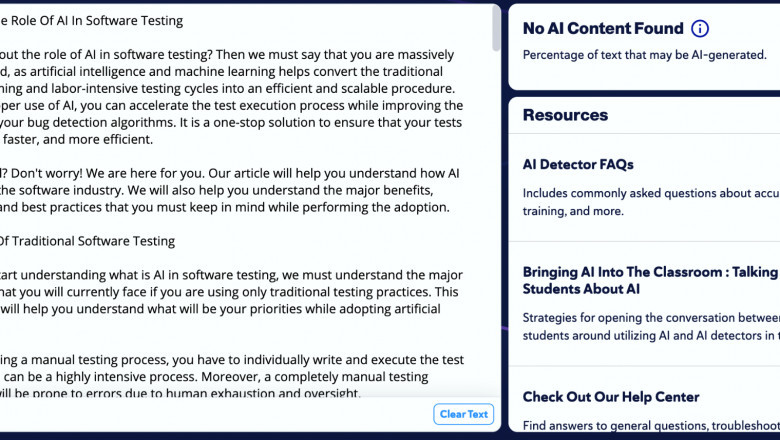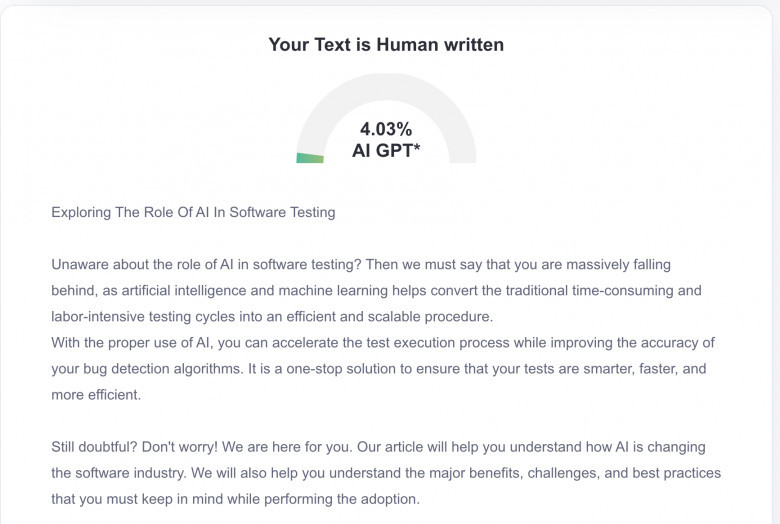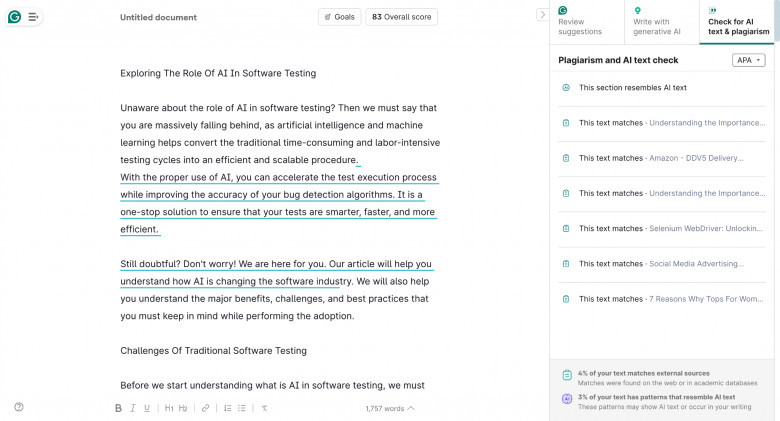views

Unaware about the role of AI in testing? Then we must say that you are massively falling behind, as artificial intelligence and machine learning helps convert the traditional time-consuming and labor-intensive testing cycles into an efficient and scalable procedure.
With the proper use of AI, you can accelerate the test execution process while improving the accuracy of your bug detection algorithms. It is a one-stop solution to ensure that your tests are smarter, faster, and more efficient.
Still doubtful? Don't worry! We are here for you. Our article will help you understand how AI is changing the software industry. We will also help you understand the major benefits, challenges, and best practices that you must keep in mind while performing the adoption.
Challenges Of Traditional Software Testing
Before we start understanding what is AI in software testing, we must understand the major challenges that you will currently face if you are using only traditional testing practices. This information will help you understand what will be your priorities while adopting artificial intelligence:
- If you are using a manual testing process, you have to individually write and execute the test cases, which can be a highly intensive process. Moreover, a completely manual testing procedure will be prone to errors due to human exhaustion and oversight.
- On the other hand, if you decide to use an automated testing process, you will have to face a very high initial investment that will cover the expenses for all the integrations and tools necessary for this process. You will also face a steep learning curve to get all your testers accustomed to this new process.
- With both manual and automation testing, one of the common challenges will be limited adaptability to dynamic testing scenarios. Dynamic testing scenarios help verify the functioning of the application when it is exposed to various real-world use cases.
- Again, with both these approaches, the test case will be brittle. This means that whenever there is any change to the user interface of the application, there is a high possibility that the entire test execution process will completely break and display a faulty or flaky test report.
Why AI In Software Testing
Now that you are properly aware of all the challenges that you will face while using traditional software testing practices, let us divert our attention towards how AI in software testing can help you solve these challenges:
- With artificial intelligence, you can go through a huge volume of data and also cover complex testing scenarios. If you're using traditional testing practices, this approach will be almost impossible to adapt. Therefore, artificial intelligence has a direct role in improving your overall test coverage.
- Artificial intelligence will help you automate the test case generation and maintenance processes. This means that you do not need to have manual intervention to check the accuracy of all these workflows. Therefore, it is a very important way to ensure faster time to market while still upholding the quality of your application.
- With the help of machine learning workflows, the system can automatically detect patterns and anomalies within the source code of your application. Using this information, it can predict the areas that have the highest possibility of developing bugs even before they can turn into a serious concern.
- Artificial intelligence uses modern workflows that can allow the test scripts to automatically adapt depending on all the UI changes. This means that you no longer have to manually update the scripts for every change in the UI or a new element that is added to the application.
Major Technologies For AI In Software Testing
Let us now divert our attention towards some of the major technologies that you can use while using AI in software testing. These technologies will help you at different stages of the application development and testing cycle:
Machine Learning
The machine learning model is an advanced algorithm that can learn from historical test data, user behavior, and code patterns. Depending on all the information that it will gather from these data sources, it can improve the test accuracy and also prioritize the test cases depending on their role in the overall functioning of the application.
Natural Language Processing
Natural language processing aims to reduce the technical requirements while creating the automation test scripts. With this process, you can create the automation test scripts in plain English, which the system will then use to convert into a language that can be natively understood by the environment.
Computer Vision
Computer vision is an advanced technology that uses visual validation by comparing user interface elements and layouts across multiple devices and platforms. The aim of this process is to ensure the pixel-perfect consistency of your application, irrespective of the device or the orientation in which the user is using it.
Predictive Analytics
Finally, predictive analytics uses historical data to identify potential areas of failure that might be present deep within the core infrastructure of your application. It also uses risk-based testing strategies to optimize the test case selection for ensuring that there are adequate test cases for verifying the functioning of all the elements.
Best Practices For AI In Software Testing
While you are using AI in software testing, there are certain practices that you must add within your environment so that you can improve the productivity, quality, and scalability of the entire workflow. To shed more light over this segment, we have mentioned some of the most effective best practices below:
Start Small
Since AI is still a very new process, we would not suggest you to convert all your test cases all at once. Instead, it is a very good idea to start small with a non-critical test case and closely monitor the parameters of its execution.
If it is a good implementation, you can slowly scale to the other areas of the software testing process. This approach will also be useful to get the initial approval from all the stakeholders when you are migrating your test environment to this advanced technology.
Use AI Tools
There are various tools available in the market which can help you adopt AI for software testing. For example, real device testing is a very important part of the application delivery pipeline as it helps you verify the functioning of the application when it is exposed to various real-world parameters.
With the help of AI cloud testing platforms, you can perform these test cases with similar accuracy without investing in a million dollar on-site device testing lab. To help you further understand the role of these platforms, let us use the example of LambdaTest.
LambdaTest is an AI-native test orchestration and execution platform that lets you perform manual and automation testing at scale with over 3000+ browser-OS combinations, and 10,000+ real devices.
Use Hybrid Testing Models
If you are using traditional rule-based automation testing, we would suggest you not to get rid of it completely. A better approach would be to combine your traditional automation test scripts with artificial intelligence, as it will help you achieve the best of both worlds.
Invest In Training
As we already mentioned earlier, a very important part of adopting AI for software testing is to train your team so that they can use all the features and functionalities of this approach. You must invest in proper training sessions and webinars so that you can reduce the learning curve for this new technology.
Continuously Monitor And Validate
While working with any form of new technology, it is very important to constantly monitor the key performance indicators so that you can understand the success of this shift. For artificial intelligence as well, you must closely monitor all the metrics while you are running the test cases. You should also validate the test cases and refine the models as per the reports that you will receive.
Use AI For Augmentation
Finally, you must remember that AI can never replace you as a human tester. This is because there are certain areas of the project that still rely on the experience of a human developer. The best approach would be to use artificial intelligence for all the repetitive test cases while you, as a tester, focus on the creative and complex areas of the project.
The Challenges Of AI In Software Testing
Although AI is a very advanced technology, it also has its own share of disadvantages. So, to prepare you for this adoption, we have outlined some of the common challenges that you might face while adopting AI in software testing:
- While working with AI models, you will need huge volumes of high-quality data to train the model so that it becomes capable of running the test cases. If you do not have this test data, you can hamper the learning process, which will in turn affect the decision-making of these models.
- To get started with AI-driven software testing, you will need a lot of expertise, including testing, programming, and data science knowledge. In most of the cases, the testing teams might not possess all of these skills at once.
- A quick glance at the market will show you that most of the common AI testing tools are still in the evolution phase. Therefore, it will be a difficult process to integrate these tools with their existing continuous integration and continuous deployment pipelines.
- The AI models often adopt a decision-making model that is referred to as a black box system. In this approach, the decision-making or the reasoning for making a judgment is often not explicitly verified or justified by the AI model.
- The initial investment to adopt multiple AI tools and training materials to get started will be very high, especially if you are a smaller company with limited revenue. This can act as a hindrance to adopting this new technology.
The Bottom Line
Based on all the areas that we have covered in this article, we can easily come to the conclusion that AI is a very important part of the modern software testing process. By using AI in software testing, the QA teams can achieve higher accuracy, better coverage, and faster delivery while maintaining the quality and the brand reputation.
Also, all the best practices that we have given in this article will help you ensure that you're utilizing the full potential of your AI-based software testing environment. Apart from this, you need to constantly look out for all the upcoming trends and innovations so that you can quickly incorporate them to provide a better end-user experience to your customers.























Comments
0 comment